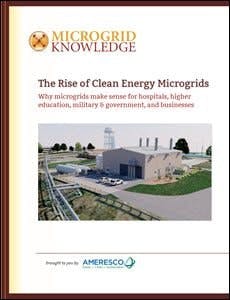The University Microgrid: Why Clean Energy and Campuses are a Good Fit
This is the third post in a Microgrid Knowledge series and focuses on the university microgrid and why clean energy and campuses are a natural fit.
Download the full report.
Colleges and universities were among the first institutions to embrace microgrids — and that’s not surprising considering how well the technology is suited to campuses.
There are now university microgrids across the country, from Wesleyan University in Connecticut to the University of California at San Diego (UCSD).
Instead of burning fuel to make steam, a university can burn a single fuel to make both electricity and steam, raising the efficiency of the system and saving money in the process.
Princeton University’s microgrid kept the lights on when Hurricane Sandy slammed into the East Coast in 2012 even as much of New Jersey remained in the dark.
UCSD’s microgrid supplies the university with about 92 percent of its electricity, but it is also set up to pull energy from the grid and can, if needed, separate from the grid and operate autonomously, what is known as “islanding.”
One of the biggest microgrids in the country is at the University of Texas at Austin. It includes a 135-MW CHP plant that produces electricity and steam, as well as a chilled water plant, a 36,000 ton-hour thermal energy storage tank, and six miles of pipes to distribute hot water and steam. It can provide all of the university’s power, heating and cooling needs.
There are many reasons why universities were among the early adopters of microgrids. The most obvious is that a university has a large and well-defined load on the grid and many campuses have historically had a physical plant to supply steam for heating. That makes them an easy candidate for upgrading to a CHP microgrid. Instead of burning fuel to make steam, a university can burn a single fuel to make both electricity and steam, raising the efficiency of the system and saving money in the process.
Squeezing efficiencies out of its CHP plant has allowed UT Austin to expand the size of its campus by millions of square feet without using more fuel, or emitting more carbon dioxide than it did in 1976.
Clean energy microgrids boost sustainability, protect research
Sustainability is also an important aspect of a university microgrid. Universities want to be good corporate citizens, and their students expect them to be. With growth slowing in college enrollment, it’s important for a university to remain attractive to environmentally conscious students. By replacing an old diesel or coal-burning boiler with a CHP microgrid, a university can cut its emissions. If the university uses a fuel cell or adds solar panels to its clean energy microgrid, it can lower emissions even further.
Research in medicine and the life sciences can involve specimens that need to be kept cold indefinitely. Losing power is not just an inconvenience, it could mean losing years of work.
UCSD’s microgrid incorporates a fuel cell powered by biogas, solar panels and electric vehicle (EV) charging stations. By enabling EV charging during periods of peak demand, the university’s microgrid can further contribute to the greening of the grid as a whole by absorbing excess solar generation from the system of its host utility, San Diego Gas & Electric.
Another part of the equation, especially for research universities, is reliability. In particular, research in medicine and the life sciences can involve specimens that need to be kept cold indefinitely. For them, losing power is not just an inconvenience, it could mean losing years of work.
At UT Austin, 80 percent of the campus is dedicated to research that is valued at $500 million. “If a professor loses a transgenic mouse with 20 years of research built into it, that’s a nightmare,” Juan Ontiveros, the university’s executive director of utilities and energy management, told Microgrid Knowledge. That adds to the value of the university microgrid, which has delivered 99.9998% reliability over the last 40 years.
Microgrids are also attractive to universities as platforms for other types of research. UT Austin uses its microgrid for research projects for the Navy and on isolated power systems. The university microgrid also serves as a platform for showcasing new distributed energy technologies. Other higher education microgrids double as educational tools for students in the engineering and environmental sciences.
Microgrids and campuses are a natural fit
There is another reason why colleges and universities are apt to embrace microgrids. Campuses, by their nature, are naturally suited to the technology. Microgrids offer local generation that can be distributed efficiently among several buildings located within a discrete geographic footprint. Further, because the college or university owns the land, the microgrid escapes certain regulatory burdens. For example, utilities prohibit privately owned electric distribution wires from crossing their rights of way without their permission. As bounded entities, colleges and universities are spared this problem when a microgrid serves multiple buildings on the campus.
Not to be forgotten, the university microgrid offers a road to good management of an institution’s energy budget. Governed by highly intelligent energy software, microgrids can be programmed to provide the most efficient, least cost energy first. In addition, they offer potential revenue opportunities. Microgrids, for example, may sell services to the electric grid, such as capacity or grid balancing.
Clearly, clean energy microgrids can serve many purposes in higher education. They can ensure electric service, contribute to sustainability goals, and create a cost-effective energy supply.
Developing the university microgrid: First step
How to get started?
The first step is to evaluate the campus’ existing energy infrastructure, model its energy usage patterns and analyze the financial implications of micro-gridding all or part of the campus. Some colleges and universities begin by applying the microgrid to only its critical infrastructure, and then expanding the system as time and capital allow. If the campus has existing on-site generators, such as solar panels, CHP or diesel generators, it may be able to incorporate them into the university microgrid—which can decrease capital expenses significantly.
A knowledgeable and experienced microgrid developer will guide the institution through this important early modeling.
The U.S. military has been another early adopter of clean energy microgrids, as we’ll describe in Chapter 4.
Over the next few weeks, the Microgrid Knowledge series on clean energy microgrids will cover the following topics:
-
Clean Energy Microgrids for the Military
-
Clean Energy Microgrids for the Commercial and Industrial Sector
-
Parris Island Microgrid Case Study
Download the full report, “The Rise of Clean Energy Microgrids: Why microgrids make sense for hospitals, higher education, military & government and businesses,” downloadable free of charge courtesy of Ameresco.







